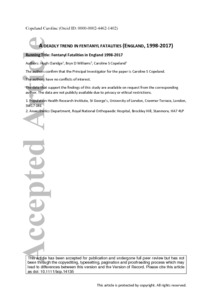Claridge, H; Williams, BD; Copeland, CS
(2020)
A deadly trend in fentanyl fatalities (England, 1998-2017).
Br J Clin Pharmacol, 86 (3).
pp. 437-444.
ISSN 1365-2125
https://doi.org/10.1111/bcp.14135
SGUL Authors: Claridge, Hugh Robert
![[img]](https://openaccess.sgul.ac.uk/114608/6.hassmallThumbnailVersion/ClaridgeWilliamsandCopeland2019-AdeadlytrendinfentanylfatalitiesEngland1998-2017.pdf)  Preview |
|
PDF
Accepted Version
Available under License ["licenses_description_publisher" not defined].
Download (1MB)
| Preview
|
Abstract
AIM: To identify trends in drug-related deaths associated with fentanyl and its derivatives, including novel variants, in England, 1998-2017. METHODS: Case reports from the National Programme on Substance Abuse Deaths (NPSAD) where a pharmaceutical fentanyl or non-pharmaceutical fentanyl derivative (NPFD) was found at post-mortem and/or implicated in the death were extracted for analysis. RESULTS: NPSAD has received case reports detailing 298 deaths in England from 1998-2017 where a fentanyl was found at post-mortem and/or implicated in the death. Hospital administered fentanyl is "very safe", whereas pharmaceutical fentanyls in the community, procured either legitimately via prescription or illegitimately, carry high risk of unintentional death. Deaths involving NPFDs, which possess extreme potencies in comparison to morphine, have drastically risen over the past three years, and correlate with an increasing number of available compounds. Males, and those with existing opioid abuse disorders, are particularly susceptible to death related to NPFD intake. CONCLUSIONS: The increasing availability of both pharmaceutical fentanyls and NPFDs represents a serious risk to public health. Unintentional misuse of these compounds in England is contributing to the exponential increase in fentanyl-associated deaths that is being observed at the global scale.
| Item Type: |
Article
|
| Additional Information: |
This is the peer reviewed version of the following article: Claridge, H, Williams, BD, Copeland, CS. A deadly trend in fentanyl fatalities (England, 1998–2017). Br J Clin Pharmacol. 2020; 86: 437– 444, which has been published in final form at https://doi.org/10.1111/bcp.14135. This article may be used for non-commercial purposes in accordance with Wiley Terms and Conditions for Use of Self-Archived Versions. This article may not be enhanced, enriched or otherwise transformed into a derivative work, without express permission from Wiley or by statutory rights under applicable legislation. Copyright notices must not be removed, obscured or modified. The article must be linked to Wiley’s version of record on Wiley Online Library and any embedding, framing or otherwise making available the article or pages thereof by third parties from platforms, services and websites other than Wiley Online Library must be prohibited. |
| Keywords: |
drug-related deaths, fentanyl, novel psychoactive substance, opioid overdose, synthetic opioid, Analgesics, Opioid, Drug Overdose, England, Fentanyl, Humans, Male, Opioid-Related Disorders, Humans, Opioid-Related Disorders, Fentanyl, Analgesics, Opioid, England, Male, Drug Overdose, drug-related deaths, fentanyl, novel psychoactive substance, opioid overdose, synthetic opioid, 1115 Pharmacology and Pharmaceutical Sciences, Pharmacology & Pharmacy |
| SGUL Research Institute / Research Centre: |
Academic Structure > Population Health Research Institute (INPH) |
| Journal or Publication Title: |
Br J Clin Pharmacol |
| ISSN: |
1365-2125 |
| Language: |
eng |
| Publisher License: |
Publisher's own licence |
| PubMed ID: |
31663152 |
| Web of Science ID: |
WOS:000508901400001 |
| Dates: |
| Date |
Event |
| 2020-03-18 |
Published |
| 2020-01-23 |
Published Online |
| 2019-08-29 |
Accepted |
|
 |
Go to PubMed abstract |
| URI: |
https://openaccess.sgul.ac.uk/id/eprint/114608 |
| Publisher's version: |
https://doi.org/10.1111/bcp.14135 |
Statistics
Item downloaded times since 10 Aug 2022.
Actions (login required)
 |
Edit Item |



